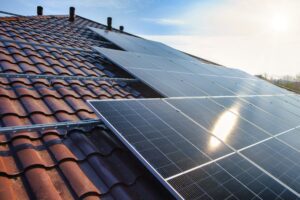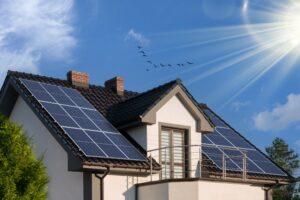Many homeowners are turning to solar power to combat climate change and avoid household budget-squeezing energy bills. Most often, installing solar panels doesn’t need planning consent. But if you live in a conservation area, it could be a different matter.
This post explores the challenges of going solar in conservation areas and how to overcome them.
Conservation Area Planning Controls
Conservation areas, introduced in 1967, have unique architectural or historical importance that needs to be preserved. These localities are mostly designated and regulated by local planning authorities (LPAs). In London, Historic England does the job.
Conservation areas are subject to specific planning controls and restrictions. These mainly affect homeowners who want to alter the appearance of their property. Solar panels are generally considered a permitted development under planning rules. But this isn’t necessarily the case in a conservation area.
How Do I Know Whether I’m In A Conservation Area?
More than 10,000 conservation areas are dotted around the UK in all local council areas. They range from historical landmark sites to country estates and long-established city suburbs and more.
If you want to install solar panels, it’s important to find out whether your home is in a conservation area. But according to research only 56 percent of people who live in a conservation area are aware of the fact.
You can find out whether you’re in a conservation area by contacting your local authority. If you’re unsure which council you come under, use a planning portal search tool.
- Create a Tailored Quote Based On Your Circumstances
- Takes Less Than 2 Minutes
- Fixed-Online Quotes

General Planning Requirements For Solar Panels
Whether you live in a conservation area or not, certain conditions apply to solar panel installation. Key considerations are:
- Panels on sloping roofs cannot protrude above the top of the roof or more than 20cm from the edge. (This isn’t typically a concern when solar panels are mounted parallel to the roof).
- Ground-mounted solar panels cannot take up more than nine square metres of land.
- Solar panels no longer in use must be removed.
- Panels should be as inconspicuous as possible to reduce visual impact.
It’s this final caveat that will most concern residents in some conservation areas who want to go solar.
When Do You Need Planning Permission For Solar Panels In A Conservation Area?
Buildings in a conservation area cannot be altered without approval from the local planning authority. This includes installing solar panels. However, formal planning permission may not be needed provided the solar installation meets regular planning considerations.
There are exceptions though. These are in conservation areas where the local planning authority implements something called the Article 4 Direction. In these localities, changes such as installing solar panels require official planning permission. And there are several strict, additional planning conditions aimed at protecting the property’s cultural significance and preserving it for future generations.
In general, the solar panels should not be obviously visible from public spaces. This means:
- The panels must not be installed on a wall facing a road or footpath.
- They must not be installed on the highest part of the roof surface.
- The panels should blend in with the building’s architecture.
Solar Panel Planning Complications
Tighter restrictions on solar panels in a conservation area under Article 4 rules can make installation a lengthy, complex process, and regulations may vary among planning authorities.
Some planning officials conduct an impact evaluation to determine how solar panels would affect the conservation area’s heritage value. It’s therefore advisable to do some research beforehand, particularly if the solar panels would be visible from the road to some extent.
You can get help from:
- Your local planning authority.
- An experienced solar panel installer.
- Heritage specialists.
- Architects familiar with conservation area planning permission conditions.
Applying For Planning Permission For Solar Panels In A Conservation Area
Each local planning authority may have its own rules on how they manage conservation areas. So before applying for planning consent for solar panels you should be aware of the specific regulations that apply in your conservation area.
The first step in making the planning application is submitting detailed plans of the proposed solar installation.
This entails completing an application form and providing information such as:
- Where the solar panels will be installed.
- What they’ll look like.
- How they’ll blend in with the property’s architecture and surroundings.
A public consultation process may take place after your planning application.
This allows neighbours and other interested parties to view and comment on your application. The planning authority takes objections into account if they’re based on valid planning concerns. (More on this later).
It usually takes around eight weeks to get a decision on planning applications. The planning authority can approve your application, reject it, or request changes.
- Create a Tailored Quote Based On Your Circumstances
- Takes Less Than 2 Minutes
- Fixed-Online Quotes

Can Neighbours Stop Me Installing Solar Panels In A Conservation Area?
As we’ve seen, if your home is in a conservation area under Article 4 planning regulations, you’ll need to seek formal planning permissions for solar panels.
Planning authorities may invite feedback from the public on some planning applications. Residents in conservation areas are almost twice as likely to oppose planning applications. They typically object to solar panels on the grounds that they’re unsightly and will negatively impact the area’s aesthetic appeal.
They also argue that a solar installation reduces a home’s value and – by extension – property prices in the entire neighbourhood. This is contrary to evidence from estate agents that eco-conscious homebuyers may be willing to pay a 20 percent premium for a house with green credentials such as solar panels.
Nevertheless, your neighbours are entitled to voice their opinion, but it’s a subjective view that may not be widely shared. And they can’t prevent you from having solar panels provided installation meets planning regulations.
How To Increase Your Chances Of Planning Approval For Solar Panels In A Conservation Area
You’ll have a better chance of getting planning consent for solar panels in a conservation area if you:
- Work with experienced planning consultants who can advise on the best design and positioning of your solar panels.
- Propose a location for your solar panels that’s as discreet as possible, such as a rear-facing roof.
- Choose a smaller solar panel array that minimises visual impact.
- Choose solar panels that blend in with the building’s design. Black panels tend to look more appealing than blue panels.
- Talk to your neighbours about your plans and address any concerns they may have.
As a leading national solar panel provider, Effective Home can also give you expert advice on installing solar panels in your conservation area. We ensure our solar panel installations are as discreet as possible and comply with all planning considerations and building regulations.
Call us on 0333 003 0703 to schedule a free survey or contact us online.
Climate Concerns Over Solar Panel Restrictions In Conservation Areas
Historic England claims more than 70 percent of the population support conservation areas. But researchers at the University of Warwick have concluded that conservation areas are significantly suppressing action on climate change.
There’s an urgent need, they said, for the government and local planning policy makers to find ways to make reducing carbon footprint easier in these areas. The researchers found that homes in conservation areas may account for more than three million tonnes of avoidable CO2 emissions a year.
Solar panels play an important role in combating climate change because they produce renewable electricity from the light energy radiating from the sun. Residential solar panels in the UK can cut carbon emissions by an average of 1.4 tonnes a year – equivalent to clocking up 3,600 miles in your car.
Solar Panels And Listed Buildings
While planning regulations in a conservation area embrace the whole neighbourhood, listed buildings have their own cultural importance and are also subject to stricter planning controls, including restrictions on solar panel installation.
The Statutory List of Buildings of Special Architectural or Historic Interest has nearly half a million registered properties. Many are older buildings with particularly high energy costs, which solar panels would reduce by up to 70 percent.
But planning conditions make solar installation more complex, and you need listed building consent (LBC) from your local council. The National Heritage List for England (NHLE) will tell you whether your home is a listed building.
- Create a Tailored Quote Based On Your Circumstances
- Takes Less Than 2 Minutes
- Fixed-Online Quotes




